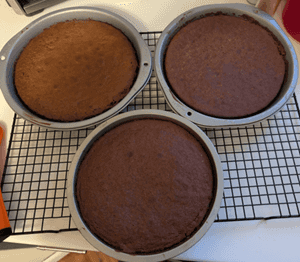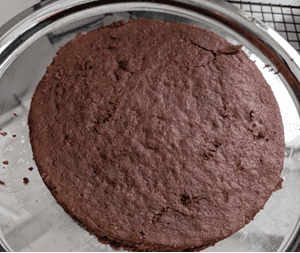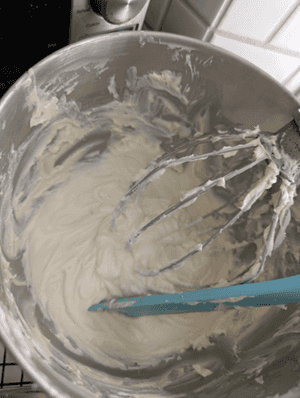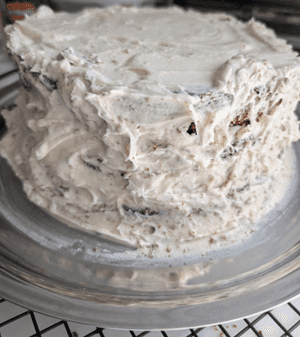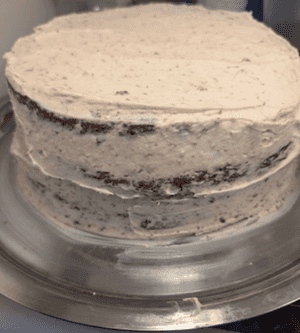Recently, I decided to tackle a homemade red velvet cake with Ermine frosting for my older son’s birthday. He asked that I’d bake him the cake as a special dessert for our family celebration. My intentions were as pure as freshly sifted flour, my spirit as bright as a perfectly beaten egg white. What could possibly go wrong? Famous last words, as it turns out. Join me on this hilariously bumpy ride through sticky situations, stubbornly pale batter, and a frosting endeavor that resembled abstract art more than elegant swirls. It’s a tale of good intentions gone sideways, but hey, at least we can mine some user experience gold from this baking catastrophe, right? Let’s dive into the delicious disaster!
Moisture Goes a Long Way
When baking the red velvet cake, it’s an art to get the balance of liquid and dry ingredients. When getting the red color, you want the right reactions from vinegar and buttermilk. You want the right source of red coloring. It needs to work well with the batter. This time around, I used beet powder straight up - instead of watering it down. Last time I made this 10 years ago, I forgot that I used beet juice, not dry coloring. I think my mix of liquid and dry ingredients was off.
This is also true for user experience. Just like a dry cake is unappealing, dry or irrelevant content can ruin a user’s experience. Ensure your information is engaging, valuable, and meets the user’s needs.
Overbaking Leads to Frustration
When baking a cake, it’s important to make sure that you don’t overbake the cake. Even baking a few minutes more than what the recipe calls for can lead to dry cake Overbaking is like a slow or unresponsive website. Users will get frustrated and “leave the oven” (your site) if things take too long or don’t perform well.
Clear Instructions Can Still Have Issues
When baking these cakes, I had followed the recipe’s guidance to butter and flour the cake pans. However, when it came time to take the cakes out of their pans, they still were sticking. As someone who doesn’t bake cakes often, I suspect I might have missed something with that. Next time, I’ll consider going the route of parchment paper or using springform pans.
Even when users follow instructions (like buttering and flouring), the process needs to be robust. Provide clear, step-by-step guidance and highlight best practices to prevent common errors. Think of tooltips or helpful hints in a user interface.
The Importance of Visual Consistency
With a red velvet cake, there are expectations of a cocoa flavor and red coloring. Some use liquid food coloring. Using the liquid beet juice last time worked really well. Using the beet powder didn’t work like I had hoped. The cakes didn’t turn red.
Users expect things to look and function as advertised. If your “red velvet cake” (your product or feature) doesn’t deliver on its visual promise, it can lead to disappointment and a feeling of being misled.
Surface Level Fixes Don’t Fix Fundamental Flaws
When I realized that the cakes were dry, I had a little hope that the Ermine frosting might be able to help. However, there’s only so much saving frosting can do in terms of flavor. When it comes to structure, you can’t rely on frosting to save the day.
A beautiful interface (frosting) can’t mask underlying usability problems (dry cake). Focus on addressing the root causes of user pain points rather than just applying cosmetic solutions. Address the underlying foundational problems rather than trying to cover up shoddy work.
Iterative Design and Refinement are Key
When it came to applying the frosting, there were a couple things that came to mind.
Iterative design allows you to design something and then rethink through those designs and change them as you come up with more ideas. This also can apply to frosting cakes.
However, keep in mind that while it might not look pretty as a work in progress, it should eventually look better.
The final presentation significantly impacts the user’s perception. A rushed or incomplete design (insufficient frosting) can leave a negative impression, even if the underlying functionality is there.
Just like frosting a cake takes practice, user experience design is an iterative process. Continuously refine and improve your product based on feedback and observation to achieve a polished and satisfying final result.
Conclusion
So, there you have it! My attempt at a homemade red velvet spectacle for my son’s birthday ended up being more of a minimalist experience. While the final product might not have graced the cover of “Baking Illustrated,” it certainly provided many user experience lessons. From the importance of well-hydrated content (or you end up with a desert in cake form) to the critical need for a non-stick foundation (because nobody wants a crumbly excavation project), this baking blunder served up some surprisingly insightful takeaways. Next year, if he asks for a cake, though, I’ll order it from a really good bakery!



